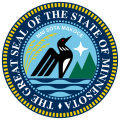| |||||||||||||||||
| |||||||||||||||||
 County results Nelson: 50–60% 60–70% 70-80% Calderwood: 50-60% 60-70% | |||||||||||||||||
| |||||||||||||||||
| Elections in Minnesota |
|---|
 |
The 1918 United States Senate election in Minnesota took place on November 5, 1918. It was the first election for Minnesota's Class 2 seat in the United States Senate, and the second U.S. Senate election in Minnesota overall, held after the ratification of the Seventeenth Amendment to the United States Constitution, which established the popular election of United States Senators. Incumbent U.S. Senator Knute Nelson of the Republican Party of Minnesota easily defeated his challenger in the general election, Willis Greenleaf Calderwood of the National Party, to win a fourth term in the Senate.

